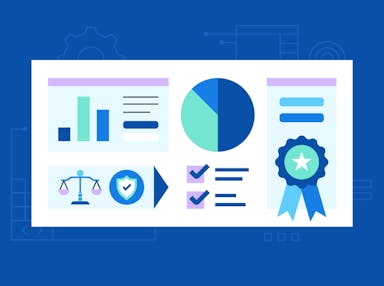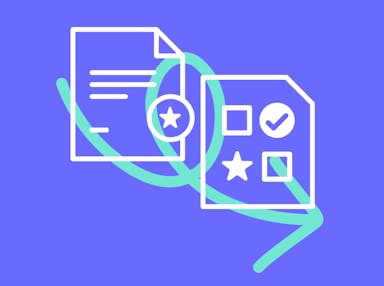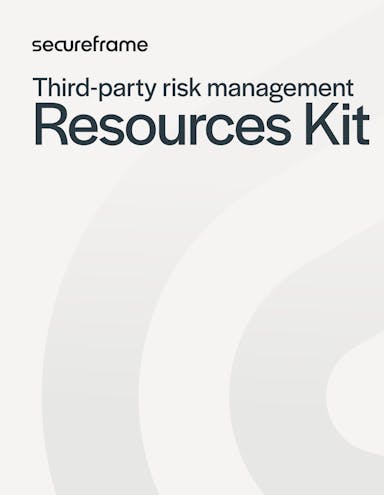
5 Hardest Things About Security Compliance and How Technology Can Help
Anna Fitzgerald
Senior Content Marketing Manager
Rob Gutierrez
Senior Cybersecurity and Compliance Manager, CISA, CCSK, CMMC RP
In Navex Global's 2023 Definitive Risk & Compliance Benchmark Report, 95% of risk and compliance professionals said their organization uses automation and technology solutions for their risk and compliance program.
Below, we’ll deep dive into how organizations can use automation and technology to address five major pain points of building and managing a security compliance program.
1. Understanding what you need to do to improve security and compliance posture
One of the most significant and persistent challenges that organizations face on their security compliance journey is understanding exactly what they need to do to improve their security and compliance posture.
First, you must understand which security frameworks you need to comply with based on the laws, regulations, and standards that apply to your industry and your customers’ expectations. You’ll also need to reassess this as you expand your business and customer base in order to manage regulatory compliance risk.
Next, what do the framework requirements mean, and what exactly needs to be implemented to meet them? Since framework requirements tend to be either very specific and complex or broad and too general to know what exactly needs to be implemented, this question can be difficult to answer unless you have experience with the respective frameworks whether that be via performing audits or having worked in internal compliance at an organization.
How you meet these requirements needs to be constantly re-assessed as well since frameworks change as technologies and the threat landscape evolve. ISO 27001, for example, released a major update in 2022. PCI DSS 4.0 was also released in 2022 and will be required starting March 31, 2024. As a result, security and compliance teams are challenged with not only reading and understanding framework requirements at a point in time, but keeping track of how they change and how new requirements may apply to their organization. 23% of security and IT professionals cited staying aware and interpreting new requirements and regulations affecting their organization as the top compliance program challenge in 2023.
While there are multiple ways to address this challenge, the most common is a manual approach. According to a survey by MetricStream, 76% of compliance managers say they manually scan regulatory websites to track changes and assess the impact on their organization. This type of approach is time-intensive and error-prone, and can leave organizations vulnerable to compliance risk.
Understanding what gaps exist in your security and compliance posture and how to fill them is an ongoing challenge that requires expertise and resources — and many risk and compliance professionals report a lack of both. In the 2023 Thomson Reuters Risk & Compliance Survey Report, the top factors cited as obstacles to a team’s confidence in their ability to address compliance risks were a lack of knowledgeable personnel and inadequate resources.
How technology can help
Many organizations use a compliance automation platform to address the pain points above, as evidenced by a survey of Secureframe users conducted by UserEvidence.* When asked what challenges led them to purchase Secureframe, 67% of Secureframe users said limited knowledge and expertise in compliance and security matters.
Using a compliance automation platform like Secureframe, you can integrate the audit-relevant softwares and tools you use every day and see exactly what you need to do based on your unique configurations and IT infrastructure. Secureframe provides a constantly evolving and up-to-date gap analysis for each framework your organization is pursuing. As you work through a framework and complete activities within the Secureframe platform, it will update showing your progress percentage toward compliance.

An automation platform can also help you keep up with framework updates so you don’t fall out of compliance — without requiring you to scan regulatory websites for changes that may impact your organization. The Secureframe team not only reaches out to notify customers of any regulatory changes affecting their compliance posture. Our platform is also built and maintained by compliance and security experts, so any regulatory changes or framework updates are reflected in the platform.
Let’s say your organization was compliant with PCI DSS v3.2.1 and now has to comply with the latest version, PCI DSS 4.0, for example. Within Secureframe, as many applicable controls from 3.2.1 as possible were mapped to 4.0 so organizations can see an accurate difference between their work in the old report versus the new report. Without this control mapping, it’d be difficult to understand what additional work is required to comply with v4.0, which may force you to waste time repeating the same activities and delay your new report.
As you strive to comply with more frameworks over time, a compliance automation platform with control mapping can also help reduce duplicate work and speed up time-to-compliance. Control mapping involves mapping the control set of one framework to the requirements of another framework in order to identify common controls. By doing so, organizations don’t have to waste valuable time and resources creating independent sets of controls, performing redundant tests, gathering the same evidence, and repeating other activities to comply with multiple frameworks that have common controls. If an existing Secureframe customer adds a new framework to their instance, they will automatically see where they stand with that framework and how it overlaps with other frameworks. Due to such common overlap across frameworks, existing Secureframe customers adding new frameworks never start at 0% when adding a new framework to their instance.
This benefit was highlighted in the Coalfire Compliance Report 2023, in which the majority of security and IT leaders (62%) cited mapping controls and systems across frameworks as a method used to manage the impact of complying with multiple compliance frameworks. 64% of large companies (more than $1 billion in annual revenue) also listed enhanced evidence mapping as the top way to effectively demonstrate compliance with multiple frameworks. While security and IT teams can manually map controls to framework requirements and tests, a GRC platform like Secureframe can automate this process, reducing the time it takes and the potential for human error.
Recommended reading

110 Compliance Statistics to Know for 2024
2. Having limited resources, which are often devoted to manual tasks like evidence collection
Another pervasive challenge that organizations face when building and managing a security compliance program is spending limited resources on manual tasks like gathering evidence, filling out security questionnaires, maintaining policies, and more. These manual tasks can be tedious, taking up valuable time and resources that would be better spent on higher priorities.
These manual tasks are not one-and-done either. If your organization relies on a manual approach to compliance, you’ll need to:
- Collect screenshots and documentation for evidence over and over for each compliance assessment
- Track dozens of tasks in spreadsheets, some of which need to be performed annually, quarterly, or on another recurring basis to maintain compliance
- Complete thorough risk assessments and gap analyses regularly as your business grows and industry standards evolve
- Create a risk register and asset inventory in spreadsheets and keep those up-to-date
- Write policies from scratch and ensure they stay updated and that employees review them as they onboard and at least annually after that
- Answer security questionnaires again and again, many of which include similar questions that require you to repeat yourself or track down previous responses
As organizations spend more resources on repetitive manual tasks like these, the complexity and costs of a security compliance program rise sharply.
How technology can help
In the 2023 Thomson Reuters Risk & Compliance Survey Report, almost two-thirds (65%) of corporate risk and compliance professionals said using technology to streamline and automate manual processes would help reduce the complexity and cost of risk and compliance.

The survey of Secureframe users conducted by UserEvidence confirmed that a platform with rich automation and AI capabilities can significantly extend a team’s limited resources. When asked what challenges led them to purchase Secureframe, 55% said engaging in time-consuming, manual processes for evidence collection, audit preparation, and compliance monitoring and 33% said inefficient and time-consuming processes for responding to RFPs and security questionnaires.
Using technology to automate the evidence collection process is particularly beneficial. In the UserEvidence survey, 79% of Secureframe users rated automated evidence collection as one of the most important Secureframe features to them. Because it has more than 200 native integrations as well as an API that can integrate with and pull evidence from any tool or service beyond those native integrations, Secureframe offers a central place to track and hold evidence for your entire security compliance program.
A compliance automation platform with AI capabilities can further help automate manual tasks related to security, risk, and compliance and supercharge your teams. With Secureframe AI, for example, you can:
- Quickly fix failing controls and improve test pass rates with AI-generated remediation guidance
- Automatically generate responses to RFPs and security questionnaires based on previous responses using machine learning
- Amplify risk management with AI-enhanced risk assessments, complete with risk treatment suggestions and residual risk scores
- Easily edit and customize policies using the AI-powered text editor to align with your organization’s needs
Recommended reading

AI in Cybersecurity: How It’s Used + 8 Latest Developments
3. Managing a security compliance program over time
Many organizations today understand security compliance is not a check-the-box activity, but struggle to manage a security compliance program over time, particularly as it increases in scope.
When asked how they spend most of their time, the second most common answer of risk and compliance professionals in the 2023 Thomson Reuters Risk & Compliance Survey Report was monitoring compliance (52%). This is not surprising when you consider that in 2023, almost 70% of service organizations said they need to demonstrate compliance or conformity to at least six frameworks spanning information security and data privacy taxonomies.
Managing a security compliance program involves more than monitoring compliance. It also involves:
- Coordinating priorities and tasks across teams
- Ensuring that multiple systems adhere to compliance requirements
- Reducing operational costs of maintaining compliance
- Understanding how regulatory changes and business decisions like expanding into new markets affect your existing compliance program
- Complying with new frameworks to meet regulatory and customer requirements
- Reducing duplicative work that comes with multiple frameworks, teams, tools, business units, and audit schedules
- Customizing your program to meet your unique expansion goals and customer expectations
Organizations that try to complete all these tasks manually will face issues with productivity, reliability, transparency, and speed.
How technology can help
Technology can help simplify the many components of security compliance management. In Navex Global's 2023 Definitive Risk & Compliance Benchmark Report, risk and compliance professionals identified several reasons related to security compliance management for adopting automation and technology solutions, including:
- To meet regulatory requirements (38%)
- To streamline workflows/reduce redundancy (22%)
- To reduce costs (21%)
- To reduce spent time on managing risk and compliance tasks (20%).

The UserEvidence survey of Secureframe users substantiated that security compliance management was a driving factor for automation and technology adoption. When asked what challenges led them to purchase Secureframe, Secureframe users selected a variety of challenges related to managing and scaling a compliance program, including:
- Lack of centralized, single source of truth in storing and managing security compliance data (57%)
- Difficulty scaling compliance programs and processes to align with business expansion goals (19%)
- Inadequate cross-department collaboration on security and compliance tasks (14%)
A compliance automation tool like Secureframe with continuous monitoring capabilities, task management, and dozens of pre-built frameworks with common controls and automated control mapping as well as custom frameworks and controls can solve these pain points.
By using an automated tool to continuously monitor their IT environment, organizations can detect potential security threats and vulnerabilities faster, stay ahead of emerging threats, and maintain a strong security posture. Automated continuous monitoring can be especially beneficial for organizations with large and complex IT environments, as it reduces the risk of human error and enables security personnel to focus on higher-priority tasks. Given all these benefits, it makes sense that the majority of Secureframe users (84%) rated continuous monitoring to detect and remediate misconfigurations as one of the most important Secureframe features to them.
A compliance automation tool can also help you remediate these misconfigurations and issues faster. With Secureframe, owners of particular assets may receive alerts about detected misconfigurations directly in the platform or via Slack. Or owners can be assigned to certain tasks with due dates, and Secureframe will create corresponding Jira tickets. When these tickets are completed, the tasks automatically resolve in Secureframe, and the linked Jira ticket can also be found in the test in-platform, ensuring prompt resolution of misconfigurations.
Recommended reading

A Guide to Regulatory Change Management & How Software Can Simplify It
Finally, a compliance automation platform can also help simplify risk and compliance management by standardizing frameworks across an organization. In the 2023 Thomson Reuters Risk & Compliance Survey Report), almost half (49%) of the surveyed corporate risk and compliance professionals said standardizing risk and compliance frameworks across their organization would help reduce the complexity and cost of the risk and compliance process.
Within the Secureframe platform, for example, you can find Secureframe-authored frameworks, which utilize common controls where possible. These controls are mapped to requirements across multiple frameworks. Secureframe also has pre-built tests that are mapped to applicable controls and prove those controls are implemented. Using these standard frameworks, controls, and tests not only saves organizations the time and headache from having to create them from scratch — it also allows organizations that have already invested time and resources in achieving compliance for one framework to effectively extend their compliance efforts to meet other framework requirements without starting over. Additionally, it enables organizations to know where they stand with other potential frameworks they may need to comply with.
Secureframe users can even create their own custom frameworks and map pre-built or custom controls and tests to those framework requirements to meet and provide evidence of adherence to these requirements. This ensures that Secureframe remains the source of truth for all compliance-related activities, even for organizations with unique or industry-specific framework requirements. Having a customizable compliance automation platform is increasingly important for growing enterprises, as evidenced by 39% of Secureframe users reporting “customization (controls, frameworks, tests)” as one of the most important Secureframe features to them in the UserEvidence survey.
Recommended reading

Supporting Enterprises through Customization: Secureframe Custom Controls and Frameworks
4. Reducing risk
In the 2023 Thomson Reuters Risk & Compliance Survey Report, risk and compliance professionals said they spend the most time identifying and assessing risk (56%).

This makes sense considering the complexity of the risk assessment process, which typically requires security and risk professionals to identify threat events and vulnerabilities, brainstorm risk categories, conduct risk formula math, and manually analyze risks, among other activities.
Despite this complexity, some organizations still manage risk on spreadsheets. This manual process is time-intensive, prone to error, and difficult to update. Spreadsheets also make it challenging to visualize all internal and external risks, assign and track risk owners and tasks, and understand how your risk profile has changed over time.
These problems compound as you scale. As your business grows and adds new employees and technology, your attack surface and risk exposure grow as well. This means it will be even more difficult to continuously identify and assess risks, implement mitigation strategies, and then re-assess the impact and likelihood of each risk to understand the residual risk your organization faces with spreadsheets.
How technology can help
Organizations of all sizes can use technology to build and maintain stronger risk management programs. In the Navex Global survey of risk and compliance professionals, reducing risk was the most prominent reason for adopting new risk and compliance automation and technology solutions (46%).
This was supported by our UserEvidence survey findings as well. When asked what the most important Secureframe features are, 55% of Secureframe users said vendor risk management and 50% said risk management. Additionally, 37% of Secureframe users reported reduced risk of data breaches and 26% reported reduced risk of fines due to non-compliance as benefits of using Secureframe.
An all-in-one risk management solution like Secureframe can address the challenges of a risk management program. For example, a solution that has a risk library and risk register will significantly reduce how much time it takes to identify, track, and document risks. Secureframe’s risk library contains a list of pre-built risks based on NIST risk scenarios with default descriptions and categories like Fraud, Legal, Finance, and IT. These can be added to your organization’s risk register to jump-start your risk management program and save you time filling out details in the risk assessment workflow. The risk register allows you to consistently document and easily monitor all the risks facing your organization in one place. It also enables you to stay aware of and assess risk changes, review risk and performance results, and continually improve risk management processes.
A risk management automation tool can also significantly streamline the risk assessment process. Secureframe users, for example, can automate risk assessment with Comply AI for Risk or follow the step-by-step workflow that follows industry best practices and aligns with many framework requirements. This workflow guides you to fill out information to describe, assess, and treat each risk, and will automatically calculate the inherent and residual risk score for you. Or you can use Comply AI for Risk to eliminate manual analysis and get almost instantaneous insights into each risk based on the risk description and company information, including its potential impact, likelihood, and recommended treatment, with clear justifications for each output.
Automation can help you effectively reduce risk as well. Secureframe users can assign risk tasks, set due dates, and send notifications through Slack, Jira, and email to enhance collaboration across the IT team and drive accountability.

They can also map mitigating controls and attach documents to risks to seamlessly align their compliance and risk management program and to easily display the steps that have been taken to mitigate risk and identify gaps so they can proactively treat and respond to risk.
Finally, a risk management solution can help you manage third-party risk. With Secureframe, you can assess and manage the security and compliance posture for each of your third-party vendors and schedule recurring reviews for continuous monitoring. Secureframe’s risk library also includes several third-party risks and there are several ways to assess and document vendor risk within the platform.

TPRM Resources Kit
Get essential tools and resources you’ll need to identify, prioritize, and mitigate third-party risk, including policy templates, checklists, and more.
5. Providing visibility to internal and external stakeholders
Visibility is key to any security compliance program. Internal stakeholders need to be able to identify and understand any security and compliance risks facing your organization. That requires you to have a holistic view of your compliance and risk management programs so you can see how your controls are performing over time, what your top risks are, and if there are any non-conformities or compliance issues across your tech stack.
This type of visibility is also important to external stakeholders, including customers and prospects. In a McKinsey Global survey of more than 3,000 consumers, 87% of respondents reported trustworthiness and data protections to be nearly as important purchase decision factors as cost and delivery time. Additionally, more than half of respondents (53%) said that they often or always make online purchases or use digital services from a company only after making sure that the company has a reputation for being trustworthy with its customers’ data.
It can be difficult to provide stakeholders with visibility into a security compliance program that is managed via spreadsheets and other manual methods. Even for organizations using technology to help manage their program, proving their security compliance posture to external stakeholders often requires admins to manually manage customer requests for security documents and NDAs.
How technology can help
In Navex Global's 2023 Definitive Risk & Compliance Benchmark Report, risk and compliance professionals identified several reasons related to reporting and greater visibility into their risk and compliance program for adopting automation and technology solutions, including:
- To increase reporting capabilities (22%)
- To improve program analytics (19%)
- To increase the number of program dimensions analyzed (12%)
The UserEvidence survey corroborated that visibility into their security compliance program was a key decision factor for Secureframe users to implement automation and technology. 55% of Secureframe users reported poor visibility into control status and overall security posture and 48% reported demonstrating a strong security and compliance posture as main challenges that led them to purchase Secureframe.
A compliance automation platform can offer dashboards and reporting exports for your security compliance and risk management programs. With Secureframe for example, the monitoring dashboard provides a high-level overview of how close your organization is to being audit-ready for the frameworks it’s pursuing. Secureframe’s Enhanced Risk Management module also includes a dashboard that enables you to visually monitor your progress over time using graphical representations of your risk data including heat maps, summary tables, trend charts, and more. Additionally, almost any part of the Secureframe platform can be exported to share with relevant personnel at your organization.
These dashboards and exports make it easy to communicate and share top risks, areas of concern, areas of improvement, and the overall health of your compliance and risk management programs to executives, auditors, and other internal stakeholders.

A Trust Center solution, on the other hand, can provide much-needed visibility to external stakeholders including current customers and potential prospects. With a customizable solution, you can show only what you want by hiding or displaying certain controls and publishing security documents for visitors to access. Secureframe Trust Center offers other benefits as well, enabling Secureframe users to:
- Proactively showcase the measures they have taken around security, compliance, and privacy
- Enable prospects to self-serve or request any security documents they need
- Streamline security reviews by allowing administrators to review, approve, and deny resource requests from their dashboard
- Create extension of website for security and trust using organization’s own branding and styling
Use Secureframe to solve the top security compliance challenges
Secureframe streamlines and automates tasks related to security, risk, and compliance like evidence collection, control monitoring, and policy management, with the flexibility to build the security compliance program that best fits your organization’s needs.
Learn more about how Secureframe streamlines security compliance on our website or reach out to schedule a demo with one of our compliance experts.
*About the UserEvidence Survey
The data about Secureframe users was obtained through an online survey conducted by UserEvidence in February 2024. The survey included responses from 44 Secureframe users (the majority of whom were manager-level or above) across the information technology, consumer discretionary, industrials, financial, and healthcare industries.
Use trust to accelerate growth

Anna Fitzgerald
Senior Content Marketing Manager
Anna Fitzgerald is a digital and product marketing professional with nearly a decade of experience delivering high-quality content across highly regulated and technical industries, including healthcare, web development, and cybersecurity compliance. At Secureframe, she specializes in translating complex regulatory frameworks—such as CMMC, FedRAMP, NIST, and SOC 2—into practical resources that help organizations of all sizes and maturity levels meet evolving compliance requirements and improve their overall risk management strategy.

Rob Gutierrez
Senior Cybersecurity and Compliance Manager, CISA, CCSK, CMMC RP
Rob Gutierrez is an information security leader with nearly a decade of experience in GRC, IT audit, cybersecurity, FedRAMP, cloud, and supply chain assessments. As a former auditor and security consultant, Rob performed and managed CMMC, FedRAMP, FISMA, and other security and regulatory audits. At Secureframe, he’s helped hundreds of customers achieve compliance with federal and commercial frameworks, including NIST 800-171, NIST 800-53, FedRAMP, CMMC, SOC 2, and ISO 27001.